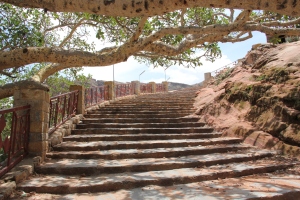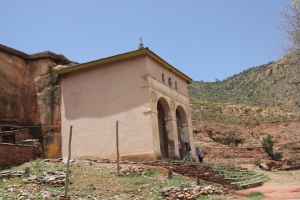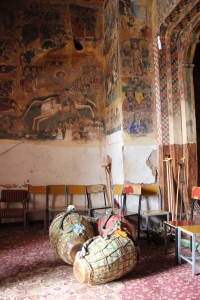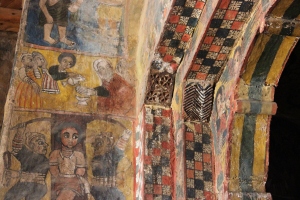The church of Abreha and Atsbeha is one of the oldest and best-known rock-hewn churches in Tigray. It lies in a rural community about 18 km west of Wukro. To get there you drive north. Just as you exit Wukro, you take a take a hard left down a long dirt and gravel road which twists and turns up and down the hills and mountains through numerous hairpin turns until you finally reach the church itself. The trip takes about 45 minutes and is well worth it. (As of this writing I have been there five times. I suppose I have become a sort of pilgrim myself).
The church sits on the side (or, rather, “in the side”) of a rocky cliff with a fantastic view of the surrounding countryside. As with the other rock-hewn churches, Abreha we Atsbeha was carved out of the side of the mountain, excavated in one piece.
According to local tradition, this church was chisled out of the mountainside between 335 AD and 340 AD by King Abreha and his twin-brother and co-regent King Atsbeha, whose mother is said to have been from this area. The church’s claim to antiquity is enhanced by multiple ancient artifacts in the adjoining museum (which in my experience is open only by special request and payment of an appropriate gratuity to the local priest). Supposedly the mummified bodies of the two brother-kings are interred within the Holy of Holies in this church and one of the guidebooks reports that the last priest who tried to open the coffin to take a peek inside had his hands badly burnt by supernatural fire, dissuading further clerical curiosity-seekers from following his example.
You park your vehicle on the road at the base of the mountain and start towards the church by entering through a stone archway . After a hundred yards or so you reach a stairway at the base of the cliff.

Archway at the base of the cliff into which the church is hewn. You can see the stone stairway at the base, to the left.

Stone stairway, which curves gracefully around the base of the cliff, rising slowly to a small plateau from which you ascend once more to enter the courtyard in front of the church.
I would not want to leave the impression that this church is merely a relic or simply a historical curiosity. As far as I can tell, this church has been in nearly continuous use for nearly 1800 years (except for a few periods of political instability, about which more later). For example, we came here on Good Friday this year and there were crowds of people in the vicinity of the church. (We were told that a funeral had just been held for a recently-deceased local). This is an active church with a large congregation–and because the church is well-known due to its antiquity, it is a site of pilgrimage for devout Orthodox believers. The day of pilgrimage is 4 Tekmet (which works out as October 14 in our calendar).
When you have climbed the stairway from the base of the cliff, you are confronted with a short, steep stairway up to the church courtyard proper, through which you enter through a small blue gate.
Crossing the courtyard, you see the church immediately ahead. There is an external portico through which you enter the church proper. The portico is a much later addition to the church complex.
If the doorway to the church is locked, you’ll have to find the priest, but because this is an active church, it is often open and being utilized.
If you do have to pay an entrance fee, be prepared to wait. You need a receipt. You need a receipt for EVERYTHING in Ethiopia. It may take a while for the priest to write you a receipt, but you are in an eternal place anyway, so make the most of it.
Once you step inside, you are in the chanting room. On Good Friday this room was occupied by a priest reading scripture aloud and an old man piously engrossed in reading his own holy texts.
The chanting room has a soft carpet on the floor, wonderful murals of Biblical scenes and illustrations from the mythologies of Christian saints, prayer crutches (for those long, long services–something lean on), and drums. Drums are an important part of worship ceremonies. The drums come with a strap so the priest can lift it, beating the drum rhythmically while singing softly in Ge’ez, the ancient liturgical language of the Ethiopian Orthodox Church. If it isn’t busy and the priest likes you (after five visits, we were becoming old friends), he will demonstrate the drumming and chanting for you outside of the regular service.
The walls of the chanting room are covered with lovely murals and each is worth exploring. You could spend hours sorting out the iconography and symbolism of these paintings, which are later than the original construction of the church.

Saint George slaying the dragon. Saint George is the most popular saint in Ethiopia (and this may have something to do with the most popular local beer bearing his name). The dragon is a symbol for pre-Christian paganism, from which Our Beloved Saint is rescuing the damsel tied up in the tree.
From the chanting room you step through another doorway into the sanctuary.
Remember, please, that this church was not built, it was carved from a solid piece of rock. All of the “open space” you see here was carved away, bit by bit, to leave the pillars, the ceiling, the walls of this church as a single piece. Amazing!

The vaulted ceiling of the church. Parts of it were blackened in a fire. Attempts were made to destroy most of the churches of Tigray by the Falasha Queen Yodit who (as the story is told) met an unpleasant end due to divine retribution as a result.
At the far end of the sanctuary is the Holy of Holies, into which only specially authorized priests may enter. In each Ethiopian Orthodox church there is a replica of the Ark of the Covenant (called the tabot). it is commonly believed that the original Ark of the Covenant (really!) is kept in the Holy of Holies in the church in Axum, in the far north of Tigray.
The Church of Abreha we Atsbeha is a place of pilgrimage, well worth a visit to those who wish to explore the Tigray Region.

View from the courtyard of the Church down to the foot of the mountain and the stone archway that opens onto the path leading to the church.




























